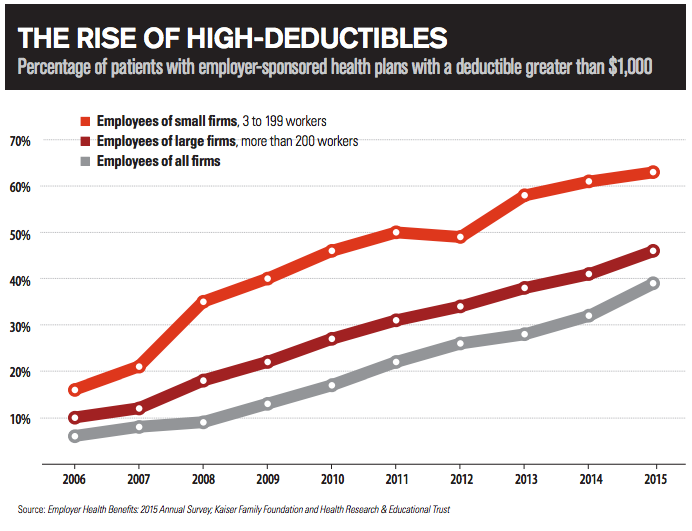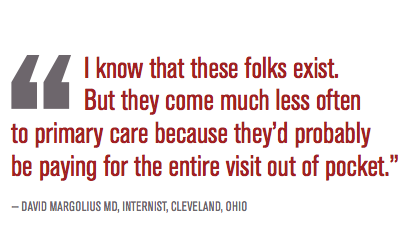Article
How physicians can deal with high-deductible plans
Understand the clinical and legal risks surrounding these plans that require patients to pay more up front.

High-deductible plans are more common in Lloyd Van Winkle’s practice these days and the South Texas family physician has also noticed more monetary pushback from patients to some of his treatment recommendations as a result.
In one case, Van Winkle referred a patient for a colonoscopy to check out the source of rectal bleeding. But the patient put off scheduling the test citing the upfront out-of-pocket costs, his staff learned when they followed up. Three months later the patient called, describing a toilet bowl filled with blood, and was sent to the emergency department. The problem turned out to be a vascular abnormality in the patient’s colon, says Van Winkle, who practices in Castroville, Texas.
The result, he says, was a partial colectomy and a hospital admission that “could have probably been prevented or at least managed less emergently if [the patient] had been seen early on.”
Hefty deductibles, relatively scarce a decade ago, have become a familiar feature on insurance policies offered by employers or sold through the Affordable Care Act (ACA) exchanges. Increasingly doctors describe related financial resistance. Patients might balk at once routine preventive visits or postpone additional testing to either identify or rule out a medical problem. While financial difficulties are nothing new, high deductible plans add a new cadre of patients who might take risks that delay diagnosis, potentially exposing the doctor to a malpractice suit. How can physicians do best by their patients medically while still protecting themselves legally?
The deductible “creates an economic disincentive to get treatment for the patient,” says Rob Francis, MBA, chief operating officer of The Doctors Company, a medical malpractice insurer. “But yet the physician is held to the same standards of care that they always were.”
Along with educating patients about why a particular treatment recommendation is important, doctors should be extra careful to document that conversation in the medical record, Francis says. That note should include why a test or referral is being recommended, and that the patient declined due to economic or insurance reasons, Francis says. “What the patient’s response was is the important part here,” he says.
Practices also should standardize their procedures for such circumstances, says Ericka Adler, JD, a Chicago-based partner at Roetzel & Andress who focuses on regulatory and transactional healthcare law. Patients should routinely be asked about the extent of their deductible, financial hardship should be documented if relevant and new doctors and other staff educated about these procedures as they join the practice, she says. “The only thing that can protect you is having a game plan.”
Next: Risking preventative care?
Risking preventative care?
In 2015, 24% of people with employer-provided insurance were enrolled in a high-deductible plan with some sort of savings option, such as a health savings account, compared with 13% in 2010, according to the latest annual benefits survey by the Kaiser Family Foundation and the Health Research & Educational Trust (HRET). Deductibles also figure on the exchanges, particularly in the bronze plans as a tradeoff for lower monthly premiums.

As these high-deductible plans-some of which don’t include a savings account option- are becoming more prevalent, the treatment fallout is still being gauged. But signs of financial discomfort are emerging. Two out of every five adults with a deductible considered to be high-defined as 5% or more of their total income-reported curtailing medical care in some way, according to a Commonwealth Fund 2015 analysis based on data from slightly more than 1,600 insured adults. Slightly more than one-fourth of patients struggling with deductibles had skipped a medical test, treatment or other follow-up measure recommended by their doctor. One-fifth reported not getting a medical problem checked out.
Among emergency physicians, 70% said they had treated patients who have delayed care due to high out-of-pocket costs, according to 1,432 surveyed last fall for the American College of Emergency Physicians (ACEP). “We see them in the emergency department once they start to decompensate because they haven’t been able to get that care,” says Ryan Stanton, MD, an ACEP spokesman and emergency physician in Lexington, Kentucky.
David Margolius MD, an internist in Cleveland, Ohio, wonders about those patients who rarely cross his office threshold in the first place. “I know that these folks exist,” says Margolius, medical director of the outpatient internal medicine practice at MetroHealth, the county-operated hospital system. “But they come much less often to primary care because they’d probably be paying for the entire visit out of pocket.”
Late in 2015, Margolius noticed an uptick in patients who he hadn’t seen previously, who he assumed had run through their deductible by then. But if they couldn’t be referred for additional care until after January 1, they didn’t want to pursue it, he says. “Because then their deductible starts all over.”
In Van Winkle’s experience, patient choices depend on how familiar they are with the deductible. If they are new to the insurance design, he says, they will wince the first time or two that they have to pay the full bill for the office visit. As those office visit bills stack up, and patients realize by mid-year that they’ve already exceeded their total out-of-pocket expenses for the entire prior year, he says, “they start to try to fall off the standard of care for monitoring different disease processes. And they’re just not showing.”
Next: Negotiating deductible deterrents
What’s particularly ironic is that patients are being asked to pay a lot more upfront to see the doctor at the same time that federal officials and other leaders are promoting concepts such as patient-centered medical homes or accountable care organizations in an effort to boost the cost-effectiveness of primary care, says Peter V. Lee, JD executive director of Covered California, California’s healthcare insurance exchange.

“It’s totally backwards from the direction that we want to go,” says Lee, who co-authored a related perspective piece published March 10 in the New England Journal of Medicine (NEJM). The result, he says, is that doctors will be “swimming upstream to convince their patients to not skip visits.”
One approach, Lee says, is to describe to the patient how they might risk a much steeper bill if they postpone visits or care in the short term. For example, a patient with diabetes might be reluctant to return for quarterly foot exams at more than $100 per office visit, he says. On the doctor’s part, it’s worth an attempt to explain that a little money invested upfront in office visits ideally will avoid landing in the hospital with a painful and costly foot amputation, Lee says.
But fight the temptation to waive fees in the face of high deductibles, Adler cautions. Doctors might do so with the best of intentions, she says, but they risk violating either their insurance contracts or federal and state laws. “Doctors are kind of caught in the middle between wanting to do a good thing and not wanting to violate the law,” she says.
Negotiating deductible deterrents
When high deductibles emerged, Adler advised her clients to get some paperwork in place and make it a routine part of their practice. First, patients should be asked to sign a document verifying that they are responsible for co-pays and deductibles. Patients who realize upfront they can’t handle the expense can be referred to publicly funded programs and charitable institutions.
Next: Avoiding fiscal malpractice
If an existing patient hits a rough patch financially, doctors can waive fees if they document financial hardship for that patient, Adler says. But that entails the patient providing financial information and that hardship status should be reviewed periodically as circumstances might change, she says.

When a doctor must refer a patient to another specialist or for a test, they lose any influence over the out-of-pocket costs, Francis says. In cases where patients resist, doctors should be sure to document the differential diagnosis and why the additional care is recommended, he says.
One approach is to draft a separate note, including the reason for the patient’s refusal, and request that the patient sign a printed copy or indicate in the electronic health record that it’s been read, Francis says. “I think it would be a pretty strong defense if a physician has made the appropriate note that the patient had the choice, and chose not to pursue that particular test,” he says. “And the patient has had an opportunity to review that note, and didn’t disagree with it.”
The practice also should regularly follow up to encourage the patient to get the appropriate test or other recommended care, Adler says. But she cautions against relying on electronic notifications, such as through a patient portal, to communicate with the patient. There’s no guarantee, she notes, that the electronic messages will ever be opened.
Avoiding fiscal malpractice
As patients and doctors discuss care options, it’s important that they don’t make erroneous assumptions about how the deductible works for specific plans, Lee says. Not all deductibles require out-of-pocket payment for all services except for an annual physical and a few tests, such as a vaccine or a mammogram, he says.
More than 80% of consumers who purchased plans on the ACA exchanges in 2015 chose policies in which some health services (beyond preventive care like cancer screenings) were covered before meeting the deductible, including 53% of consumers on bronze plans, according to the Centers for Medicare & Medicaid Services. In Covered California, all bronze plan enrollees can get one free primary care visit and three other visits that aren’t subject to the deductible, according to the NEJM perspective piece.
Next:Navigating this new landscape
Lee maintains that physicians also are engaging in a form of fiscal malpractice if they don’t make a concerted effort to identify more affordable locations for common tests and referrals. Otherwise a patient who is referred for a CT scan might blanch at the cost and skip it entirely. That decision not only undermines the patient’s care, but potentially his or her relationship with the doctor, Lee says. How can you think your doctor is looking out for you, he asks, if they send you to a place that you can’t afford?
Meanwhile, doctors like Van Winkle do their best to navigate this new high-deductible landscape with their patients. He recounts another story, one involving a man with a basal cell skin cancer on his ear. The typical approach would be to refer him to a dermatologist for Mohs surgery. But the patient couldn’t afford the $1,000-plus dermatology bill: the cancer was frozen instead in Van Winkle’s office.
Although it’s a less-costly procedure, the cancer is more likely to recur, so Van Winkle is very closely following the patient. In cases where Van Winkle hits high-deductible resistance, he says, “the obvious thing is you have to document the fact that you made the assessment, and you made the referral.”
Patients are free to refuse treatment for whatever reason, Van Winkle says. But with these high-deductible plans, he says, it’s not the patient’s choice. “That’s disturbing. That goes against the grain of most docs.”





